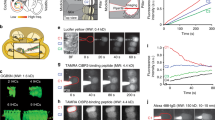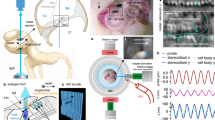Abstract
Outer hair cells are centrally involved in the amplification and frequency tuning of the mammalian cochlea, but evidence about their transducing properties in animals with fully developed hearing is lacking. Here we describe measurements of mechanoelectrical transducer currents in outer hair cells of rats between postnatal days 5 and 18, before and after the onset of hearing. Deflection of hair bundles using a new rapid piezoelectric stimulator evoked transducer currents with ultra-fast activation and adaptation kinetics. Fast adaptation resembled the same process in turtle hair cells, where it is regulated by changes in stereociliary calcium. It is argued that sub-millisecond transducer adaptation can operate in outer hair cells under the ionic, driving force and temperature conditions that prevail in the intact mammalian cochlea.
This is a preview of subscription content, access via your institution
Access options
Subscribe to this journal
Receive 12 print issues and online access
$209.00 per year
only $17.42 per issue
Buy this article
- Purchase on SpringerLink
- Instant access to full article PDF
Prices may be subject to local taxes which are calculated during checkout





Similar content being viewed by others
References
Hudspeth, A.J. How the ear's works work. Nature 341, 397–404 (1989).
Gillespie, P.G. & Walker, R.G. Molecular basis of mechanosensory function. Nature 413, 194–195 (2001).
Fettiplace, R., Ricci, A.J. & Hackney, C.M. Clues to the cochlear amplifier from the turtle ear. Trends Neurosci. 24, 169–175 (2001).
Crawford, A.C., Evans, M.G. & Fettiplace, R. Activation and adaptation of transducer currents in turtle hair cells. J. Physiol. 419, 405–434 (1989).
Assad, J.A., Hacohen, N. & Corey, D.P. Voltage dependence of adaptation and active bundle movement in bullfrog saccular hair cells. Proc. Natl. Acad. Sci. USA 86, 2918–2922 (1989).
Eatock, R.A., Corey, D.P. & Hudspeth, A.J. Adaptation of mechanoelectrical transduction in hair cells of the bullfrog's sacculus. J. Neurosci. 7, 2821–2836 (1987).
Eatock, R.A. Adaptation in hair cells. Annu. Rev. Neurosci. 23, 285–314 (2000).
Wu, Y.-C., Ricci, A.J. & Fettiplace, R. Two components of transducer adaptation in auditory hair cells. J. Neurophysiol. 82, 2171–2181 (1999).
Ricci, A.J., Wu, Y.-C. & Fettiplace, R. The endogenous Ca2+ buffer and the time course of transducer adaptation in auditory hair cells. J. Neurosci. 18, 8261–8277 (1998).
Russell, I.J., Cody, A.R. & Richardson, G.P. The responses of inner and outer hair cells in the basal tunr of the guinea-pig cochlea and in the mouse cochlea grown in culture. Hear. Res. 22, 199–216 (1986).
Kros, C.J., Rüsch, A. & Richardson, G.P. Mechano-electrical transducer currents in hair cells of the cultured neonatal mouse cochlea. Proc. R. Soc. Lond. B 249, 185–193 (1992).
Holt, J.R. et al. A chemical-genetic strategy implicates myosin-1c in adaptation by hair cells. Cell 108, 371–381 (2002).
Kros, C.J. et al. Reduced climbing and increased slipping adaptation in cochlear hair cells of mice with Myo7a mutations. Nat. Neurosci. 5, 41–47 (2001).
Ashmore, J.F., Kolston, P.J. & Mammano, F. Dissecting the outer hair cell loop. Biophysics of Hair Cell Sensory Systems (eds. Duifhuis, H., Horst, J.W., van Dijk, P. & van Netten, S.M.) 151–157 (World Scientific, Singapore, 1993).
Meyer, J., Furness, D.N., Zenner, H.P., Hackney, C.M. & Gummer, A.W. Evidence for opening of hair-cell transducer channels after tip-link loss. J. Neurosci. 18, 6748–6756 (1998).
Yates, G.K., Johnstone, B.M., Patuzzi, R.B. & Robertson, D. Mechanical preprocessing in the mammalian cochlea. Trends Neurosci. 15, 57–61 (1992).
Nobili, R., Mammano, F. & Ashmore, J.F. How well do we understand the cochlea? Trends Neurosci. 21, 159–167 (1998).
Robles, L. & Ruggero, M.A. Mechanics of the mammalian cochlea. Physiol. Rev. 81, 1305–1352 (2001).
Dallos, P. The active cochlea. J. Neurosci. 12, 4575–4585 (1992).
Zheng J. et al. Prestin is the motor protein of cochlear outer hair cells. Nature 405, 145–155 (2000).
Liberman, M.C. et al. Prestin is required for electromotility of the outer hair cell and for the cochlear amplifier. Nature 419, 300–304 (2002).
Corey, D.P. & Hudspeth, A.J. Kinetics of the receptor current in bullfrog saccular hair cells. J. Neurosci. 3, 962–976 (1983).
Bosher, S.K. & Warren, R.L. Very low calcium content of cochlear endolymph, an extracellular fluid. Nature 273, 377–378 (1978).
Crawford, A.C., Evans, M.G. & Fettiplace, R. The actions of calcium on the mechano-electrical transducer current of turtle hair cells. J. Physiol. 434, 369–398 (1991).
Ricci, A.J. & Fettiplace, R. Calcium permeation of the turtle hair cell mechanotransducer channel and its relation to the composition of endolymph. J. Physiol. 506, 159–173 (1998).
Ricci, A.J. & Fettiplace, R. The effects of calcium buffering and cyclic AMP on mechano-electrical transduction in turtle auditory hair cells. J. Physiol. 501, 111–124 (1997).
Crowley, D.E. & Hepp-Reymond, M.C. Development of cochlear function in the ear of the infant rat. J. Comp. Physiol. Psychol. 62, 427–432 (1966).
Uziel, A., Romand, R. & Marot, M. Development of cochlear potentials in rats. Audiology 20, 89–100 (1981).
Blatchley, B.J., Cooper, W.A. & Coleman, J.R. Development of auditory brainstem response to tone pip stimuli in rat. Dev. Brain Res. 32, 75–84 (1987).
Roth, B. & Bruns, V. Postnatal development of the rat organ of Corti II. Hair cell receptors and their supporting elements. Anat. Embryol. 185, 571–581 (1992).
Oliver, D. & Fakler, B. Expression density and functional characteristics of the outer hair cell motor protein are regulated during postnatal development in the rat. J. Physiol. 519, 791–800 (1999).
Belyantseva, I.A., Adler, H.J., Curi, R., Frolenkov, G.I. & Kachar, B. Expression and localization of prestin and the sugar transporter GLUT-5 during development of electromotility in cochlear outer hair cells. J. Neurosci. 20, RC116 (2000).
Marcotti, W. & Kros, C.J. Developmental expression of the potassium current IK,n contributes to maturation of mouse outer hair cells. J. Physiol. 520, 653–660 (1999).
Housley, G.D. & Ashmore, J.F. Ionic currents of outer hair cells isolated from the guinea-pig cochlea. J. Physiol. 448, 73–98 (1992).
Nenov, A.P., Norris, C. & Bobbin, R.P. Outwardly rectifying current in guinea-pig outer hair cells. Hear. Res. 105, 146–158 (1997).
Kharkovets, T. et al. KCNQ4, a K+ channel mutated in a form of dominant deafness is expressed in the inner ear and the central auditory pathway. Proc. Natl. Acad. Sci. USA 97, 4333–4338 (2000).
Holt, J.R. & Corey, D.P. Two mechanisms for transducer adaptation in vertebrate hair cells. Proc. Natl. Acad. Sci. USA 97, 11730–11735 (2000).
Fettiplace, R., Crawford, A.C. & Ricci, A.J. The effects of calcium on mechanotransducer channel kinetics in auditory hair cells. Biophysics of the Cochlea: from Molecules to Models (ed. Gummer, A.W.) 65–72 (World Scientific, Singapore, 2003).
Benser, M.E., Marquis, R.E. & Hudspeth, A.J. Rapid, active hair bundle movements in hair cells from the bullfrog's sacculus. J. Neurosci. 16, 5629–5643 (1996).
Ricci, A.J., Crawford, A.C. & Fettiplace, R. Active hair bundle motion linked to fast transducer adaptation in auditory hair cells. J. Neurosci. 20, 7131–7142 (2000).
Martin, P. & Hudspeth, A.J. Active hair-bundle movements can amplify a hair cell's response to oscillatory mechanical stimuli. Proc. Natl. Acad. Sci. USA 96, 14306–14311 (1999).
Hudspeth, A.J. Mechanical amplification of stimuli by hair cells. Curr. Opin. Neurobiol. 7, 480–486 (1997).
Hille, B. Ion Channels of Excitable Membranes 3rd edn. (Sinauer, Sunderland, 2001).
Bosher, S.K. & Warren, R.L. A study of the electrochemistry and osmotic relationships of the cochlear fluids in the neonatal rat at the time of development of the endocochlear potential. J. Physiol. 212, 739–761 (1971).
Kikuchi, T., Kimura, R.S., Paul, D.L., Takasaka, T. & Adams, J.C. Gap junction systems in the mammalian cochlea. Brain Res. Rev. 32,163–166 (2000).
Mammano, F. & Ashmore, J.F. Differential expression of outer hair cell potassium currents in the isolated cochlea of the guinea pig. J. Physiol. 496, 639–646 (1996).
Nobili, R. & Mammano, F. Biophysics of the cochlea II: stationary nonlinear phenomenology. J. Acoust. Soc. Am. 99, 2244–2255 (1996).
Glowatzki, E. & Fuchs, P.A. Cholinergic synaptic inhibition of inner hair cells in the neonatal mammalian cochlea. Science 288, 2366–2368 (2000).
Müller, M. Frequency representation in the rat cochlea. Hear. Res. 51, 247–254 (1991).
Dallos, P. Neurobiology of cochlear inner and outer hair cells. Hear. Res. 22, 185–198 (1986).
Acknowledgements
This work was supported by grant RO1 DC 01362 to R.F. from the National Institutes on Deafness and other Communicative Disorders (NIH) and travel grants to M.G.E. and H.J.K. from the Wellcome Trust.
Author information
Authors and Affiliations
Corresponding author
Ethics declarations
Competing interests
The authors declare no competing financial interests.
Supplementary information
Supplementary Fig. 1. (a)
Low-power view of isolated cochlear coil showing arrangement of recording pipette and stimulating probe.The preparation was secured by four ties one of which is visible near the top of the image.The recording pipette was inserted along the longitudinal axis of the cochlea. (b) Method for stimulating stereociliary bundle.The bundle was deflected by axial motion of a fire-polished glass probe driven by a piezoelectric stack actuator. The apical surface of the hair cell on the right shows that the tip of the glass probe fit into the 'V' of of the outer hair cell bundle. Diameter of probe tip was ∼3 μm. (JPG 47 kb)
Rights and permissions
About this article
Cite this article
Kennedy, H., Evans, M., Crawford, A. et al. Fast adaptation of mechanoelectrical transducer channels in mammalian cochlear hair cells. Nat Neurosci 6, 832–836 (2003). https://doi.org/10.1038/nn1089
Received:
Accepted:
Published:
Issue Date:
DOI: https://doi.org/10.1038/nn1089
This article is cited by
-
The sensitivity of mechanoelectrical transduction response phase to acoustic overstimulation is calcium-dependent
Pflügers Archiv - European Journal of Physiology (2024)
-
The summating potential polarity encodes the ear health condition
Cellular and Molecular Life Sciences (2023)
-
Artificial fast-adapting mechanoreceptor based on carbon nanotube percolating network
Scientific Reports (2022)
-
Mechanisms in cochlear hair cell mechano-electrical transduction for acquisition of sound frequency and intensity
Cellular and Molecular Life Sciences (2021)
-
Probing hair cell’s mechano-transduction using two-tone suppression measurements
Scientific Reports (2019)



